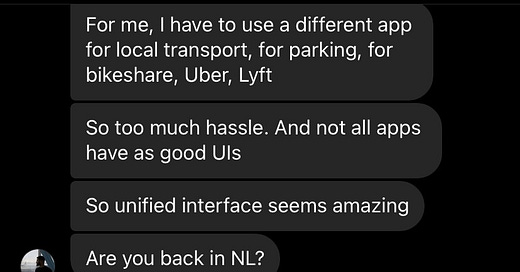The Big Quest for a Seamless Urban Mobility Experience
Consumers increasingly want their urban travel needs to be addressed in a seamless fashion, but are the stakeholders ready yet?
Consumers increasingly expect their daily lives to be seamlessly and digitally integrated. Take an example of super apps, particularly in Asia, like WeChat, PhonePe, PayTM, Grab and many more.
Back home here in Europe, we find similar seamless digital experiences across different sectors (if not bundled up into one). For example, we are seeing rise of new fintech apps in the age of open banking that keep your finances manageable at the tip of your fingers.
Plaid revolutionised how developers can build innovative and smart fintech applications and services without having to deal with individual banks. You can build an amazing expense management app targeting users in an altogether different geography. Amazing, no?
The UPI stack enabled multifold increase in digital transactions across applications in India without the buyer and the seller to be on the same central platform (no, it doesn’t involve blockchain).
Emerging protocols and APIs have made opportunities to thrive which were unimaginable earlier opening doors to innovations and unlocking new models of communications and value deliveries.
Enter urban mobility and we quickly realise that we are far behind.
Last week, a friend of mine from my university days, residing in Toronto, dropped me a message detailing his pain points around his urban travel needs. “So unified interface seems amazing,” he mentioned. Indeed, it would be amazing!
But, are we there yet? Most multi-modal travel journeys are still a huge pain for consumers. You need to install multiple apps for various types of travel needs. And may God bless you if you are in a new city!
The mobility service delivery model in today’s ecosystem is based on the premise that the rider and the service provider need to be the same platform in order to have any meaningful conversations. For instance, both the driver and the rider need to come together on a central platform like Uber to discover each other and make a transaction.
As a result, these service providers have their own unique user acquisition channels and strategies. They then try to solve their users’ problems independently in silos. If you consider an end consumer of mobility services, just like this friend of mine, the consumer has the fundamental requirement of moving from location A to location B. The challenge here is to make that seamless, taking into the consumers’ choice and convenience at their own location online. For service providers, the challenge is to make their services discoverable at lowest possible cost.
However, let me leave you with some food for thought. Let’s say you have a gmail account. And I need to send you an email. In order to do that, do I have to mandatorily create my own gmail account and then be able to send you an email? No, right? All I need to know is your email ID in order to initiate communication with you. And how is that made possible? The answer is SMTP, short for Simple Mail Transfer Protocol. Mail servers and other message transfer agents use this protocol to exchange mail messages. Simple, it is!
The private and public digital infrastructure evolved in siloes, making interoperability a huge challenge. To address this challenge, multiple working groups spun up to come up with standards (private, public, open) to open up mobility — think open banking for mobility. In fact, that’s what we have been talking about back here in the Netherlands (and Europe) - MaaS, short for Mobility-as-a-Service, considered as the holy grail for a seamless urban mobility digital experience. Regulations are trying to change this and push for more openness via emerging standards and obligations. Legislation is being published and enforced across EU wherein mobility operators need to be made accessible for MaaS Providers, publish data & comply with standards.
However, the promise of MaaS is far from delivered. Because the real challenge is in the implementation that works for every stakeholder.
Mobility is a complex population-scale problem. And to simplify this and eventually solve this, the stakeholders need to come together instead of working in silos. We believe the following three points hold the key to the future of urban mobility -
(1) Interoperability over integrations
(2) Unification, not standardisation — recognise the diversity of offerings.
(3) Open Network, instead of centralised intermediaries.
Let there be no doubt that this decade will see (and in fact is seeing) a paradigm shift in urban mobility and the digital experience associated with it. And we couldn’t be more excited than be a part of this shift.




